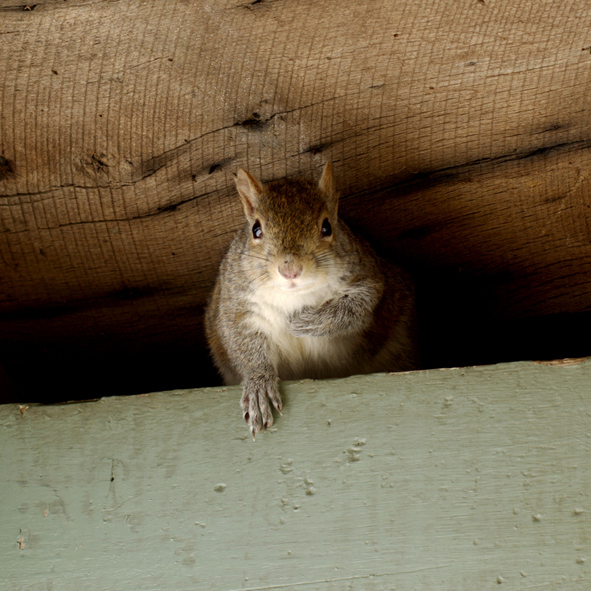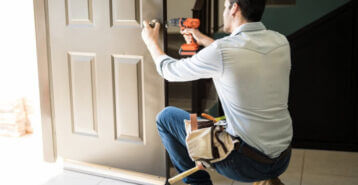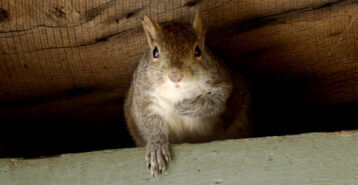Are you doing a home improvement project?
Modernize can pair you with three to four pros in your area, so you can compare options and save time and money.
Wildlife can be beautiful, and having animals near your home can be an enjoyable way to immerse yourself in nature as you relish the view. However, there are times when animals get too close for comfort — they stop being part of the scenery and start becoming a nuisance that causes damage to your home. Here’s why animals might be taking over your property, and what you can do if you find them taking up residence in and around your home.
Why So Much Wildlife is Taking Over People’s Homes and Yards
Wildlife is increasingly coming onto homeowners’ property. As people develop urban and suburban areas, we encroach more and more on animals’ natural habitats. Animals must adapt to this change, but that also means that we have to live with them. This can be a real challenge for many homeowners.
Animals will search for basic necessities: food, water, and shelter. Once they establish a food source, they will stay as close to it as possible. Things like vegetation, ponds, and kitchen compost can make your home very inviting to animals.
It is helpful to think about this issue from the animals’ perspective. They do not see it as our home — they just see a safe place to breed, with an abundance of food to eat. The more we understand what animals find attractive as a dwelling space, the better we can modify our homes so we do not face these conflicts.
How Feeding Wildlife Contributes to This Problem
Feeding birds or mammals can have a negative impact because it creates a false habitat. Plus, providing abundant food leads to breeding.
Bird houses are OK to have on your property, especially for certain species of birds that have lost the fight in our habitat modification, like bluebirds. But feeding birds directly can create a lot of problems.
How to Prevent Wildlife From Becoming a Problem
Luckily, there are preventative measures you can take as a homeowner to keep animals out of your home and property moving forward.
When Building a New House
If you are building a new house, look for exterior products and materials that are capable of resisting animals’ efforts to get in. If you are building your house up on a platform — for example, if it is surrounded by lattice — you should take extensive measures to properly exclude wildlife from the design. Start by asking your architect and contractor if they have taken steps when planning to keep animals out of the home. Some exterior products and materials are plastic, and not very hardy, which makes them very vulnerable to a determined animal.
Animal-Proofing Your Current Home
If you have lived in your house a while, do not wait until you have a wildlife problem. At that point, there is not a happy ending for the animal, You could end up spending a lot of money on pest removal—not to mention dealing with the stress of having wildlife in or under your home.
At some point, take a look around your house and see if you notice places where animals could potentially become a problem. You can hire a professional to walk your property with you to suggest some preventive steps you can take, especially if you notice a lot more wild animals showing up.
Always make sure trash and food are in covered areas. You can get locks for your trash cans to ensure animals cannot access them during the night. Look for cracks and holes that animals can easily get into, and make sure to seal them up.
Find the Right Contractor for Your Project
Whether you’re ready to begin your project now or need some expert advice, our network of contractors are here to help. With a few simple questions, we’ll find the best local professionals for you
Monitor Vents and Small Spaces
Every house is different, but some things are consistent from house to house. For example, any place that ventilates air — such as exhaust vents, attics, crawl spaces, ridge vents, kitchen and bathroom fan vents, and dryer vents — are areas that animals are typically attracted to. This is because of the warmth that comes out of these places. It is like a cavity in a tree: protected, safe, and in the case of the vents, warm. Because these areas are often not properly protected from animals, that makes them very vulnerable.
Animals, with their claws and teeth, are well-equipped to get through many materials. But sometimes we make it easy for them by not closing off vents and ducts properly.
How to Deal With the Most Common Pests
There are several kinds of pests that can be handled in different ways. For example:
Bats
A pest removal professional may not trap bats, but instead inspect the structure that they have gotten into—like the attic—to identify all entry points and vulnerabilities. Then, they will install one-way doors to allow them to exit. This way, the bats will be able to leave on their own, and not be able to return.
Deer
Likewise, with deer, your pest removal professional may not need to trap them. Instead, depending on the property, they may erect a 10-foot tall fence so they can’t get onto the property. One of the biggest complaints homeowners have about deer is that they eat their ornamental plants. So you can either put in plants deer do not usually like, or you can put up fencing to keep them out.
Squirrels
Squirrels tend to congregate around fruit and nut trees, as well as flowers. In order to deter them, you can prune trees or spray repellent made of hot pepper and peppermint around trees and flowers. Also, bird feeders are another spot that squirrels love. In order to get rid of them, you can put out squirrel-proofed bird feeders in your yard or remove them altogether.
Raccoons
If you want to trap raccoons yourself, you can bait them to a trap with peanut butter, raw eggs, or dried corn on the cob. To discourage them from coming on your property, secure your trash cans, remove bird feeders from your backyard, and keep pet food inside of the house.
Rodents
You can trap rodents, such as mice, and dispose of them yourself using traps. If you do not feel comfortable with killing them, catch them in no-kill traps and release them at least three miles from your home. This way, they likely will not be able to find their way back. To prevent them from entering your home in the future, you can weather-strip the bottom of garage and basement doors, and seal exterior gaps.
Although there is no one template for resolving every wildlife issue, understanding how animals behave can go a long way toward keeping animals out of your home. If you need guidance, be sure to work with your pest removal contractor to find the right solution for your home.
Find the Right Contractor for Your Project
Whether you’re ready to begin your project now or need some expert advice, our network of contractors are here to help. With a few simple questions, we’ll find the best local professionals for you
Reviews from Real Homeowners
Welcome to Homeowner Resources! We are the Modernize blog. Modernize pairs more than 3 million homeowners a year with pre-vetted contractors in their area. This blog started because we believe homeowners should know everything about their homes, from how their HVAC works to which front door colors they might love. On Homeowner Resources, you can find information on every part of your home, right down to how you can negotiate with contractors to get the best price. Here's more about the blog.
Need a contractor? Learn more about how Modernize finds the right pro for you.



